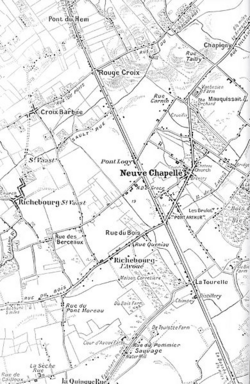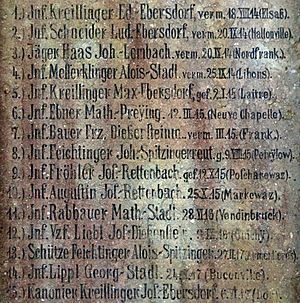Battle of Neuve Chapelle facts for kids
Quick facts for kids Battle of Neuve Chapelle |
|||||||||
|---|---|---|---|---|---|---|---|---|---|
| Part of the Western Front of the First World War | |||||||||
 Neuve Chapelle area, 1914–1915 |
|||||||||
|
|||||||||
| Belligerents | |||||||||
| Commanders and leaders | |||||||||
| Strength | |||||||||
| 4 divisions | 2 divisions | ||||||||
| Casualties and losses | |||||||||
| 12,892 c. 7,000 British c. 4,200 Indian |
9–20 March: 8,500–10,000 | ||||||||
The Battle of Neuve Chapelle was a major fight during the First World War. It happened from March 10 to 13, 1915, in the Artois region of France. The British and Indian armies planned this attack to break through German lines. Their goal was to capture important areas like Aubers Ridge and possibly Lille.
A French attack was also planned at Vimy Ridge. This would help by threatening German supply routes from the south. However, the French part of the plan was changed. British troops could not replace a French army group near Ypres. So, the French could only help with their heavy artillery.
The Royal Flying Corps (RFC), which was the British air force, took many photos from the sky. These photos helped create detailed maps of the battle area. This was the first time such detailed maps were used in a British attack. The Battle of Neuve Chapelle showed how trench warfare would be fought for the rest of the war.
The British army planned the attack very carefully. They managed to surprise the Germans and break through their defenses. But unexpected delays and communication problems slowed everything down. Soldiers and artillery couldn't work together when their telephone lines broke. This gave the Germans time to bring in more troops and dig new trenches.
The British tried to attack again where they had failed before. They didn't send more troops to where they were winning. A large German counter-attack on March 12 failed, but it used up most of the British artillery shells. Because of this, the British stopped their attack on March 13. The Germans then made their defenses stronger in the area. After this battle, the French felt more confident that British forces could fight well in attacks.
Contents
The Battle Begins
Despite bad weather, the battle started very well for the British. The RFC quickly took control of the sky. They bombed German railways and troop movements.
At 7:30 a.m. on March 10, the British began a 35-minute artillery bombardment. Many guns fired at the German wire fences, destroying them in ten minutes. Other big guns fired at the German front-line trenches. These trenches were only about 3 feet deep and 4 feet high. They could not stand up to the powerful howitzer shells.
The 1st Canadian Division also helped. They fired artillery and machine guns to distract the Germans. This stopped the Germans from sending more troops to Neuve Chapelle. After the bombing, the infantry (foot soldiers) attacked at 8:05 a.m.
| Gun Type | Number | Shells Fired |
|---|---|---|
| 13-pounder gun | 60 | 600 |
| 18-pounder gun | 324 | 410 |
| 4.5-inch howitzer | 54 | 212 |
| 60-pounder gun | 12 | 450 |
| 4.7-inch gun | 32 | 437 |
| 6-inch howitzer | 28 | 285 |
| 6-inch gun | 4 | 400 |
| 9.2-inch howitzer | 3 | 333 |
| 2.75-inch gun | 12 | 500 |
| 15-inch howitzer | 1 | 40 |
Indian Troops Advance
The Garhwal Brigade of the Indian Corps attacked with four battalions. On the right side, the attack quickly went wrong. The soldiers lost their way and moved too far to the right. They faced German defenses that had not been bombed by the artillery. Even so, the Indian troops pushed through the German wire. They captured about 200 yards of the German front trench, but suffered many losses.
On the left, three Lahore battalions advanced quickly. They crossed 200 yards of "no man's land" in just fifteen minutes. They overcame the German soldiers and pushed on to the German support trench. The leading companies then moved past the Port Arthur–Neuve Chapelle road. They captured the village by 9:00 a.m., taking 200 prisoners and five machine guns.
German Resistance and Delays
A gap of 250 yards was created where the Indian troops had lost direction. Here, a small group of German soldiers fought on bravely. A new British attack was planned from the north. But German troops managed to sneak northwards. They were eventually pushed back by grenade throwers and bayonet charges. However, the Indian attack was stopped by the Germans.
The German defenses in the center were quickly taken over a wide front. Neuve Chapelle was captured by 10:00 a.m. The British commander, Sir John French, sent the 5th Cavalry Brigade. They were meant to rush through the expected breakthrough. But on the left side of the attack, about 200 German soldiers with a machine gun held up the advance for over six hours. This left no time to continue the attack.
Even though aerial photos were helpful, they couldn't find all the strong German positions. Also, old-fashioned communications meant British commanders couldn't talk to each other. The battle became disorganized, and supplies couldn't get through. On March 12, the German 6th Army counter-attacked. This attack failed, but it forced the British to use most of their artillery ammunition. The British attack was stopped on March 13 and completely given up two days later.
Aftermath
Casualties
The British army had about 7,000 casualties (killed, wounded, or missing). The Indian Corps had about 4,200 casualties out of 40,000 troops. The 7th Division lost 2,791 soldiers, and the 8th Division lost 4,814. The Meerut Division had 2,353 casualties, and the Lahore Division had 1,694.
German casualties from March 9 to 20 were estimated to be between 8,500 and 10,000 soldiers. The 6th Bavarian Reserve Division alone lost 6,017 soldiers from March 11 to 13. During its supporting attack, the 1st Canadian Division had 300 casualties, with nearly 100 deaths.
Commemoration and Legacy
The Neuve-Chapelle Indian Memorial remembers 4,700 Indian soldiers and workers. They died on the Western Front during the First World War and have no known graves. This location was chosen because the Battle of Neuve Chapelle was the first big attack fought by the Indian Corps. War graves for Indian soldiers are found at Ayette, Souchez, and Neuve-Chapelle. This battle was also the first major fight for the Canadian Expeditionary Force.
Victoria Cross
The Victoria Cross is the highest award for bravery in the British military. Several soldiers earned this medal during the Battle of Neuve Chapelle:
- Corporal William Anderson, 2nd Battalion, The Green Howards.
- Private Edward Barber, 1st Battalion, The Grenadier Guards.
- Private William Buckingham, 2nd Battalion, Leicestershire Regiment.
- Company Sergeant-Major Harry Daniels, 2nd Battalion, The Rifle Brigade.
- Captain Charles Calveley Foss, 2nd Battalion, Bedfordshire Regiment.
- Lance Corporal Wilfred Dolby Fuller, 1st Battalion, The Grenadier Guards.
- Lieutenant Cyril Gordon Martin, 56th Field Company R. E. (3rd Division).
- Rifleman Gabbar Singh Negi, 2nd Battalion, 39th Garhwal Rifles.
- Corporal Cecil Noble, 2nd Battalion, The Rifle Brigade.
- Private Jacob Rivers, 1st Battalion, Sherwood Foresters.
See also


